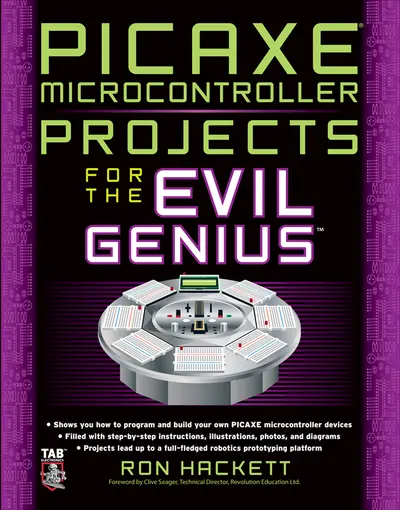My Account Details

ISBN10: 0071703268 | ISBN13: 9780071703260

Step 1 . Download Adobe Digital Editions to your PC or Mac desktop/laptop.
Step 2. Register and authorize your Adobe ID (optional). To access your eBook on multiple devices, first create an Adobe ID at account.adobe.com. Then, open Adobe Digital Editions, go to the Help menu, and select "Authorize Computer" to link your Adobe ID.
Step 3. Open Your eBook. Use Adobe Digital Editions to open the file. If the eBook doesn’t open, contact customer service for assistance.
Publisher's Note: Products purchased from Third Party sellers are not guaranteed by the publisher for quality, authenticity, or access to any online entitlements included with the product.
WHIP UP SOME FIENDISHLY FUN PICAXE MICROCONTROLLER DEVICES
"Ron has worked hard to explain how the PICAXE system operates through simple examples, and I'm sure his easy-to-read style will help many people progress with their PICAXE projects." --From the Foreword by Clive Seager, Revolution Education Ltd.
This wickedly inventive guide shows you how to program, build, and debug a variety of PICAXE microcontroller projects. PICAXE Microcontroller Projects for the Evil Genius gets you started with programming and I/O interfacing right away, and then shows you how to develop a master processor circuit.
From "Hello, World!" to "Hail, Octavius!"
All the projects in Part I can be accomplished using either an M or M2 class PICAXE processor, and Part II adds 20X2-based master processor projects to the mix. Part III culminates in the creation of Octavius--a sophisticated robotics experimentation platform featuring a 40X2 master processor and eight breadboard stations which allow you to develop intelligent peripherals to augment Octavius' functioning. The only limit is your imagination!
PICAXE Microcontroller Projects for the Evil Genius:
- Features step-by-step instructions and helpful photos and illustrations
- Allows you to customize each project for your purposes
- Offers all the programs in the book free for download
- Removes the frustration factor--all required parts are listed, along with sources
Build these and other devious devices:
- Simple mini-stereo jack adapter
- USBS-PA3 PICAXE programming adapter
- Power supply
- Three-state digital logic probe
- 20X2 master processor circuit
- TV-R input module
- 8-bit parallel 16X2 LCD board
- Serialized 16X2 LCD
- Serialized 4X4 matrix keypad
- SPI 4-digit LED display
- Countdown timer
- Programmable, multi-function peripheral device and operating system
- Octavius--advanced robotics experimentation platform
- L298 dual DC motor controller board
Each fun, inexpensive Evil Genius project includes a detailed list of materials, sources for parts, schematics, and lots of clear, well-illustrated instructions for easy assembly. The larger workbook-style layout and convenient two-column format make following the step-by-step instructions a breeze.
Make Great Stuff!
TAB, an imprint of McGraw-Hill Professional, is a leading publisher of DIY technology books for makers, hackers, and electronics hobbyists.
Need support? We're here to help - Get real-world support and resources every step of the way.